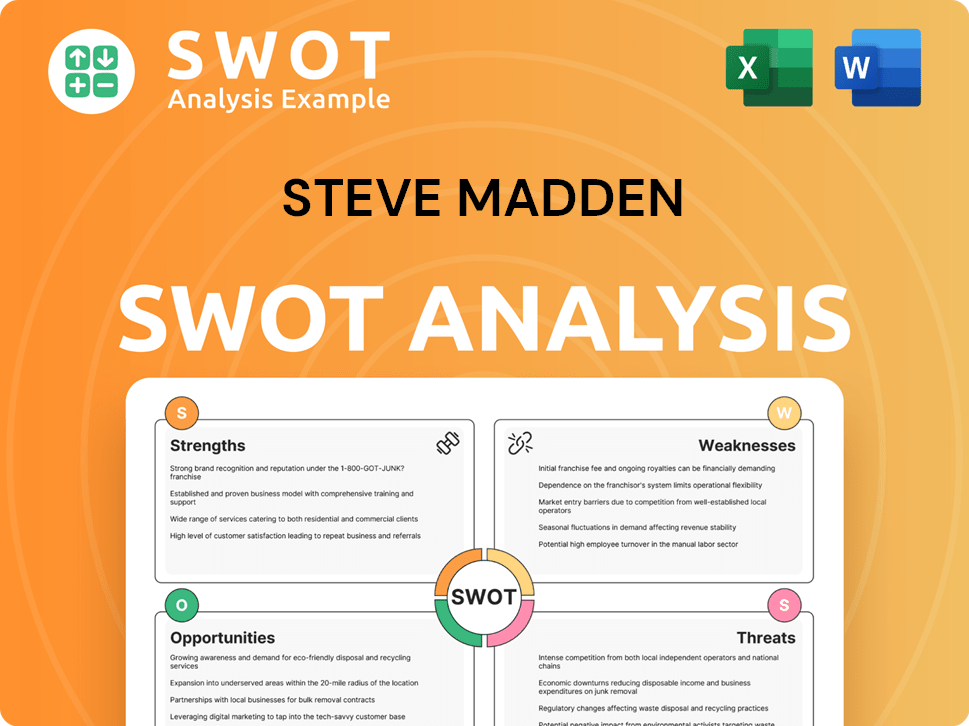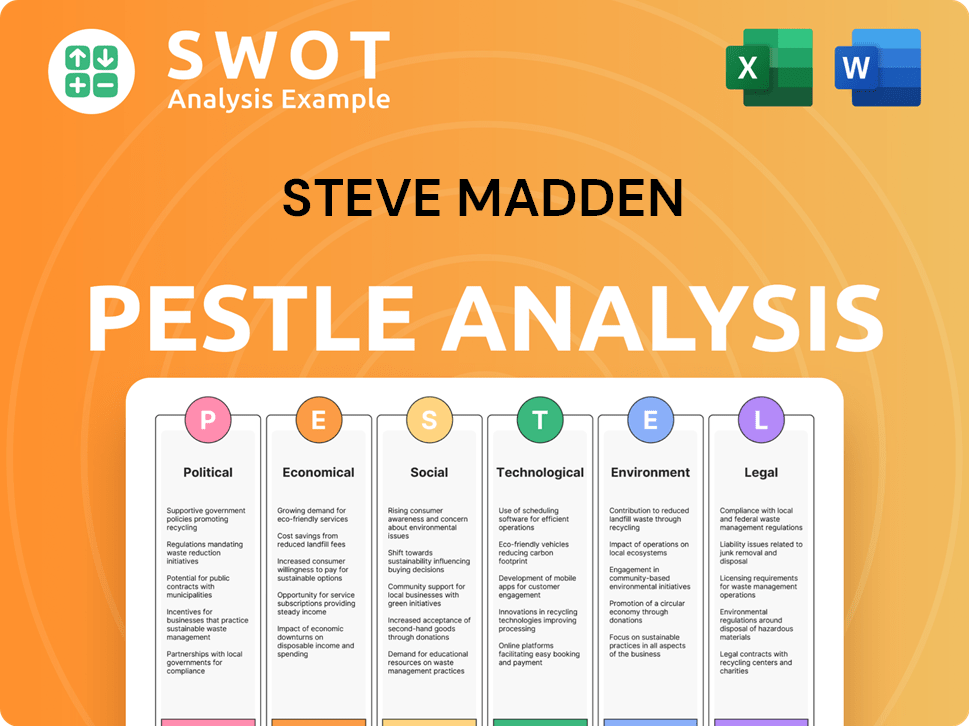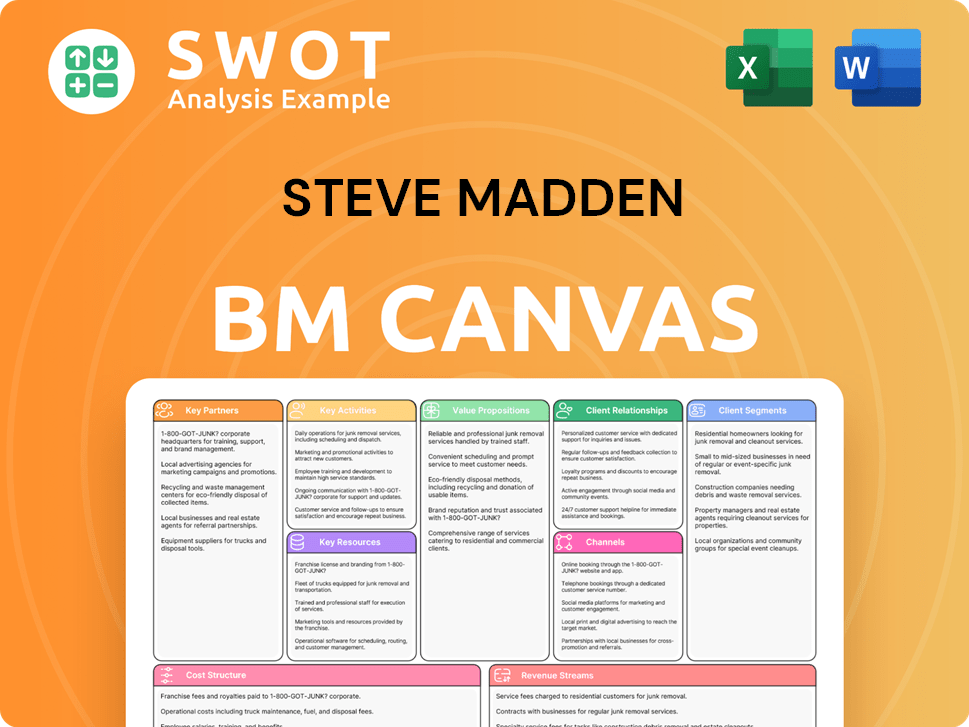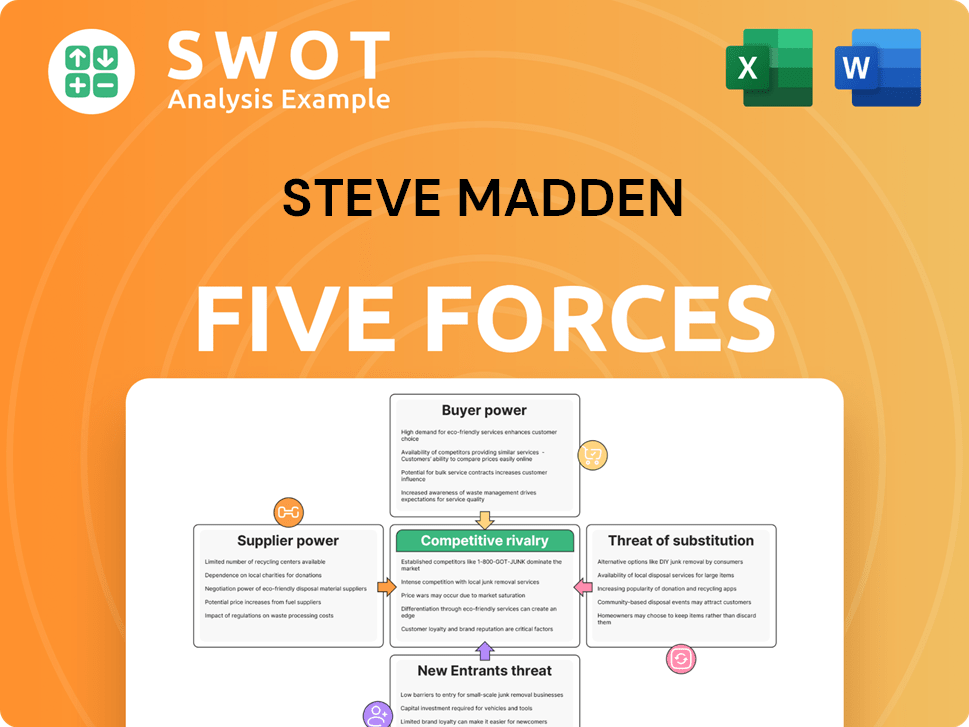Steve Madden Bundle
How Did Steve Madden Build a Fashion Empire?
In 1990, with a mere $1,100, Steve Madden launched a footwear revolution from the trunk of his car in Queens, New York. His vision: to create stylish, affordable shoes for the masses, a goal that quickly took off. This Steve Madden SWOT Analysis will reveal the brand's strategic landscape.

From its humble beginnings, the Steve Madden company has become a global lifestyle brand, a testament to its founder's entrepreneurial spirit and keen understanding of the fashion market. Understanding the Steve Madden history is crucial for appreciating the company's evolution and its lasting impact on the industry. This Steve Madden brand story encompasses pivotal moments, strategic decisions, and the challenges that shaped its remarkable journey from a small startup to a fashion powerhouse, including its Steve Madden shoes and the Steve Madden founder's impact.
What is the Steve Madden Founding Story?
The Steve Madden brand was established in 1990, marking the beginning of the Steve Madden history. Steve Madden, the founder, a former shoe salesman, saw a chance to create fashionable, affordable footwear. This vision quickly transformed into a business model that would reshape the footwear industry.
The Steve Madden company was built on the idea of providing trendy shoes that reflected street style. This approach allowed the brand to connect with a broad audience. The company's early success laid the foundation for its future growth and expansion in the competitive fashion market.
Steve Madden founded his company in 1990, starting with a keen understanding of consumer demand and design trends.
- The initial investment was a modest $1,100, showcasing the brand's entrepreneurial spirit.
- Madden personally delivered shoes, highlighting a hands-on approach to sales and distribution.
- The first product was a chunky platform shoe, which quickly gained popularity.
- The company name, Steve Madden, directly reflected its founder and brand identity.
Steve Madden SWOT Analysis
- Complete SWOT Breakdown
- Fully Customizable
- Editable in Excel & Word
- Professional Formatting
- Investor-Ready Format

What Drove the Early Growth of Steve Madden?
The early growth of the Steve Madden company was fueled by the immediate success of its unique footwear designs, which perfectly matched the fashion trends of the early 1990s. Following the initial success of its platform shoes, the company quickly expanded its product range to include a wider variety of women's footwear styles, adapting to changing consumer preferences. Early sales milestones were marked by increasing demand from boutiques and department stores, leading to the establishment of its first official office and showroom in New York City.
The company's strategic expansion into new markets began with a focus on growing its wholesale presence across the United States. This allowed the Steve Madden brand to reach a broader audience and increase its market share. This approach was crucial in establishing a strong foundation for future growth and brand recognition.
Concurrently, Steve Madden shoes began to explore international distribution, gradually entering markets beyond North America. This move was essential for diversifying its revenue streams and increasing its global footprint. This expansion helped the company establish itself as a global player in the footwear industry.
Key to this early growth was the company's agility in responding to fashion trends and its ability to deliver products quickly to market. This responsiveness allowed the company to capitalize on emerging styles and maintain a competitive edge. Being quick to market was a significant factor in its early success and brand building.
While specific early acquisitions or major capital raises beyond its initial bootstrapping are not widely publicized as defining moments in its nascent stages, the company's organic growth was robust, driven by strong product appeal and effective distribution. By the mid-1990s, the Steve Madden company had firmly established itself as a recognizable brand in the footwear industry, laying the groundwork for its subsequent public offering and further diversification.
Steve Madden PESTLE Analysis
- Covers All 6 PESTLE Categories
- No Research Needed – Save Hours of Work
- Built by Experts, Trusted by Consultants
- Instant Download, Ready to Use
- 100% Editable, Fully Customizable

What are the key Milestones in Steve Madden history?
The Steve Madden history is filled with significant moments that have shaped the Steve Madden brand. From its humble beginnings to its current status as a global fashion leader, the company has navigated various challenges and celebrated numerous successes. The Steve Madden company has shown resilience and adaptability in the ever-changing fashion industry, solidifying its place in the market.
| Year | Milestone |
|---|---|
| 1990 | Steve Madden launches his company with a $1,100 investment, selling shoes from the trunk of his car. |
| 1993 | The company goes public, expanding its reach and resources for growth. |
| 2000s | The brand expands its product line to include handbags, accessories, and apparel, becoming a lifestyle brand. |
| 2002 | Steve Madden faces legal challenges, leading to a restructuring of the company's leadership and operations. |
| 2010s-2020s | The company focuses on digital expansion and strategic acquisitions to maintain market relevance and growth. |
A key aspect of the Steve Madden shoes success has been its ability to quickly adapt to fashion trends. The company's efficient design and production processes have allowed it to introduce new styles rapidly, keeping the brand relevant in the fast-paced fashion world.
The brand's ability to quickly translate runway trends into accessible footwear has been a core innovation, allowing it to stay ahead of the curve and capture market share.
Introducing iconic styles like the 'Slinky' platform slide and chunky-soled designs has cemented the brand's place in fashion history, creating cultural touchstones.
Expanding beyond women's footwear to include men's shoes, accessories, and apparel has broadened its market reach and solidified its position as a lifestyle brand.
Investing in digital platforms and e-commerce has been crucial for adapting to changing consumer behaviors and maintaining a strong online presence.
Strategic acquisitions of complementary brands and businesses have expanded the company's portfolio and market share, driving overall growth.
Optimizing the supply chain to manage costs and reduce lead times has been essential for maintaining profitability and responsiveness to market demands.
The Steve Madden founder faced significant challenges, including legal issues in the early 2000s, which led to restructuring. More recently, the company has navigated the evolving retail landscape, including increased e-commerce competition and supply chain disruptions.
The legal issues faced by the founder required strategic restructuring and strengthened corporate governance to rebuild trust and ensure continued operation.
Adapting to the rise of e-commerce and increasing competition from online retailers has required significant investment in digital platforms and marketing strategies.
Navigating supply chain disruptions and inflationary pressures has been a challenge, requiring careful management of costs and inventory to maintain profitability.
Responding to changing consumer preferences and fashion trends requires continuous innovation in design and marketing to stay relevant and meet evolving demands.
Preserving the brand's identity and design integrity amidst market changes and challenges is crucial for retaining customer loyalty and brand value.
Adapting to the changing retail landscape, including the rise of online shopping and shifting consumer behaviors, requires strategic investments and innovative approaches.
For a deeper dive into the competitive landscape, consider reading about the Competitors Landscape of Steve Madden.
Steve Madden Business Model Canvas
- Complete 9-Block Business Model Canvas
- Effortlessly Communicate Your Business Strategy
- Investor-Ready BMC Format
- 100% Editable and Customizable
- Clear and Structured Layout

What is the Timeline of Key Events for Steve Madden?
The Steve Madden company has a rich history, marked by significant milestones and strategic shifts. The Steve Madden brand started in Queens, New York, in 1990, and has since grown into a global fashion leader. From its initial public offering to its recent financial successes, the company's journey reflects its adaptability and resilience in the dynamic fashion industry. The Growth Strategy of Steve Madden highlights the company’s innovative approaches.
| Year | Key Event |
|---|---|
| 1990 | Steve Madden founded in Queens, New York, with $1,100. |
| 1993 | Initial Public Offering (IPO) on NASDAQ. |
| Early 2000s | Founder Steve Madden faces legal issues and conviction, leading to a period of corporate restructuring. |
| 2005 | Company celebrates 15th anniversary, demonstrating resilience post-founder's legal issues. |
| 2010s | Significant expansion into international markets and diversification into accessories and apparel. |
| 2013 | Acquires Brian Atwood footwear brand. |
| 2014 | Acquires Dolce Vita and Report brands. |
| 2015 | Acquires Schwartz & Benjamin. |
| 2017 | Acquires Greats, a men's sneaker brand. |
| 2020 | Celebrates 30th anniversary amidst the global pandemic, adapting to increased e-commerce demand. |
| 2023 | Reports strong financial results, with net sales increasing by 13.7% in the first quarter to $543.8 million. |
| 2024 | Continues to focus on direct-to-consumer growth and international expansion. |
| 2025 | Expected to continue leveraging its robust e-commerce platforms and expanding its global footprint, particularly in emerging markets, while focusing on product innovation and sustainable practices. |
Steve Madden plans to enhance its direct-to-consumer channels, including e-commerce and retail stores. This strategy aims to strengthen customer relationships and boost profitability. The focus on digital platforms reflects the evolving consumer behavior and the need for seamless shopping experiences.
International expansion is a key element of the long-term strategy. The company is particularly focused on growing its presence in underserved markets. This strategic move aims to capitalize on global demand and diversify revenue streams, driving overall growth.
Product innovation, especially in sustainable materials and manufacturing, is a core focus. This approach aligns with industry trends and consumer demand for environmentally conscious products. Incorporating sustainable practices enhances the brand's appeal and social responsibility.
Analyst predictions suggest continued resilience despite economic fluctuations. The company's diversified portfolio and agile business model position it for sustained performance. This positions the brand for long-term success.
Steve Madden Porter's Five Forces Analysis
- Covers All 5 Competitive Forces in Detail
- Structured for Consultants, Students, and Founders
- 100% Editable in Microsoft Word & Excel
- Instant Digital Download – Use Immediately
- Compatible with Mac & PC – Fully Unlocked

Related Blogs
- What is Competitive Landscape of Steve Madden Company?
- What is Growth Strategy and Future Prospects of Steve Madden Company?
- How Does Steve Madden Company Work?
- What is Sales and Marketing Strategy of Steve Madden Company?
- What is Brief History of Steve Madden Company?
- Who Owns Steve Madden Company?
- What is Customer Demographics and Target Market of Steve Madden Company?
Disclaimer
All information, articles, and product details provided on this website are for general informational and educational purposes only. We do not claim any ownership over, nor do we intend to infringe upon, any trademarks, copyrights, logos, brand names, or other intellectual property mentioned or depicted on this site. Such intellectual property remains the property of its respective owners, and any references here are made solely for identification or informational purposes, without implying any affiliation, endorsement, or partnership.
We make no representations or warranties, express or implied, regarding the accuracy, completeness, or suitability of any content or products presented. Nothing on this website should be construed as legal, tax, investment, financial, medical, or other professional advice. In addition, no part of this site—including articles or product references—constitutes a solicitation, recommendation, endorsement, advertisement, or offer to buy or sell any securities, franchises, or other financial instruments, particularly in jurisdictions where such activity would be unlawful.
All content is of a general nature and may not address the specific circumstances of any individual or entity. It is not a substitute for professional advice or services. Any actions you take based on the information provided here are strictly at your own risk. You accept full responsibility for any decisions or outcomes arising from your use of this website and agree to release us from any liability in connection with your use of, or reliance upon, the content or products found herein.